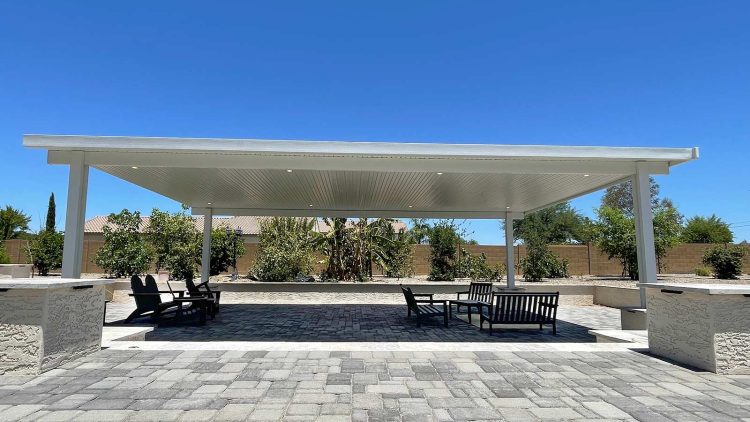Vinyl Patio Cover Cost 2025
The cost of installing a vinyl patio cover in 2025 varies based on factors like size, design complexity, and regional labor rates. Here’s a breakdown to help you estimate potential expenses:
💲 Average Cost of Vinyl Patio Covers (2025)
-
Per Square Foot Installed: $25 to $80
This range depends on the design and installation complexity. -
Total Installed Cost: $5,000 to $16,000
This estimate is for a standard 10′ x 20′ patio cover.
📏 Cost by Patio Size
| Patio Size | Square Footage | Estimated Cost Range |
|---|---|---|
| 10′ x 10′ | 100 sq ft | $2,500 – $8,000 |
| 10′ x 20′ | 200 sq ft | $5,000 – $16,000 |
| 12′ x 20′ | 240 sq ft | $6,000 – $19,200 |
| 20′ x 20′ | 400 sq ft | $10,000 – $32,000 |
Note: These estimates are based on the $25 to $80 per square foot range.
🛠️ Factors Influencing Cost
-
Design Complexity: Features like louvered or adjustable tops can increase costs.
-
Roof Type: Installing on tile or steep roofs may require additional labor.
-
Permits: Local building permits can add to the overall expense.
-
Customization: Unique designs or finishes may raise the price.
🏜️ Considerations for Phoenix, AZ
In Phoenix’s hot and sunny climate, vinyl patio covers are a popular choice due to their durability and low maintenance. However, it’s essential to ensure that the materials used can withstand high temperatures and UV exposure.
Popular Designs For Patio Covers
There are lots of great patio cover designs out there depending on your style, climate, and how much sun or shade you want. Here’s a breakdown of the most popular patio cover designs right now:
🏡 Popular Patio Cover Designs (2025)
1. Lattice (Pergola Style)
-
Open-roof design with slats or beams
-
Allows partial sunlight, perfect for climbing plants
-
Can be wood, aluminum, or vinyl
-
💡 Great for: Style + light filtering
2. Solid Roof (Insulated or Non-Insulated)
-
Full roof cover, often with insulated panels or shingles
-
Provides complete protection from sun and rain
-
Can be matched to your house’s roofline
-
💡 Great for: Full shade + rain protection
3. Gable Roof (Pitched/A-Frame)
-
Triangular roof for a more open, airy feel
-
Allows better air circulation and can match home’s architecture
-
More structural work, but adds elegance
-
💡 Great for: Higher-end look + ventilation
4. Flat Roof Cover
-
Sleek, modern design with clean lines
-
Often made from aluminum, steel, or vinyl
-
Slight pitch for drainage, but looks flat from below
-
💡 Great for: Modern homes + budget-friendly shade
5. Retractable Covers
-
Fabric awnings or louvered systems that open/close manually or with a motor
-
Allows for sun when you want it, shade when you don’t
-
Some even include rain sensors and smart tech
-
💡 Great for: Versatility + tech-savvy setups
6. Louvered Roof (Adjustable Slats)
-
Motorized or manual slats that tilt open or shut
-
Let in sunlight or seal tight for rain protection
-
Often made from powder-coated aluminum
-
💡 Great for: Ultimate control + year-round use
7. Solar Panel Roof
-
Dual purpose: provides shade and generates electricity
-
Often integrated into solid-roof patio covers
-
Can qualify for solar tax credits
-
💡 Great for: Eco-conscious upgrades
🎨 Style Tips
-
Match your patio cover’s color and materials to your house trim or roof
-
Add ceiling fans, lighting, or curtains for function and flair
-
Mix wood with metal or vinyl for a hybrid aesthetic
How Long Do Patio Covers Last?
The lifespan of a patio cover depends heavily on the material, how it’s installed, and how well it’s maintained. Here’s a breakdown by material:
⏳ Average Lifespan of Patio Covers (By Material)
🟦 Vinyl Patio Covers
-
Lifespan: 20–30 years
-
Pros: Low maintenance, won’t rust or rot
-
Cons: Can become brittle in extreme heat or cold over time
🪵 Wood Patio Covers (Cedar, Redwood, Pressure-Treated)
-
Lifespan: 10–20 years
-
Pros: Classic, natural look
-
Cons: Needs regular sealing/painting to prevent rot, pests, or warping
🟫 Aluminum Patio Covers
-
Lifespan: 30–40 years
-
Pros: Rust-resistant, lightweight, durable
-
Cons: Can dent easily; plain aluminum may not match all home styles
🟨 Steel Patio Covers
-
Lifespan: 40–50+ years (with proper treatment)
-
Pros: Very strong and durable
-
Cons: Heavier; more expensive to install
🌦️ Fabric or Canvas Covers (Retractable Awnings)
-
Lifespan: 5–10 years (fabric), 15–20 years (frame)
-
Pros: Flexible use, retractable
-
Cons: Fabric fades, tears, or mildews over time
🔧 Factors That Affect Longevity
-
Climate: UV rays, humidity, snow, and wind all wear materials down
-
Maintenance: Cleaning, sealing, and checking for damage extends life
-
Installation Quality: A solid frame and proper drainage make a big difference
-
Design: Sloped roofs that shed water last longer than flat ones that pool
🏠 Quick Tip (for Arizona & Hot Climates):
-
Vinyl and aluminum are very popular because they hold up well in heat and need very little maintenance.
-
Look for UV-resistant coatings or insulated roof panels for max durability.

